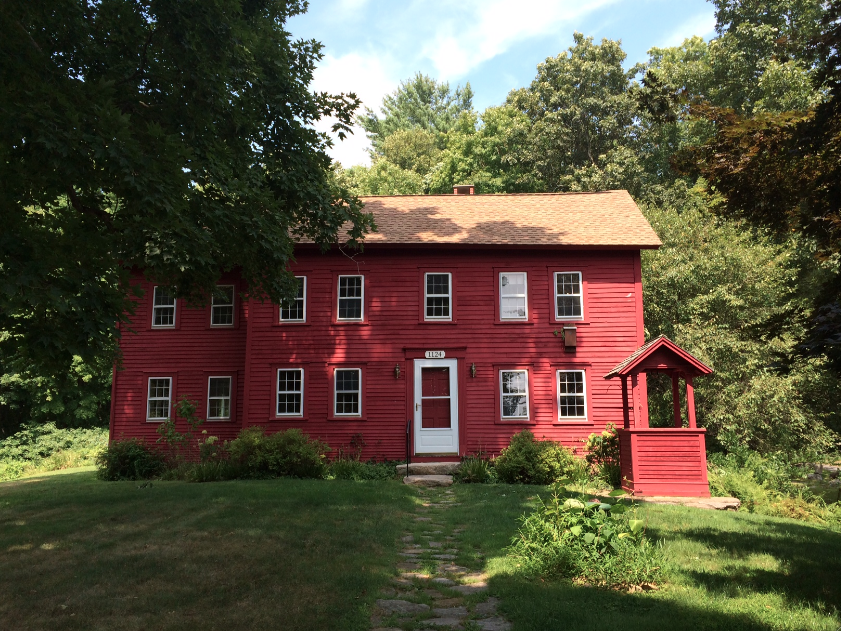The town will contribute about $100,000 toward the purchase of an antique house on upper Valley Road that a prominent local nonprofit organization is in the process of purchasing, New Canaan’s highest elected official said.
As he’d indicated last month, First Selectman Kevin Moynihan told the Board of Finance during its April 11 meeting that the New Canaan Land Trust “has succeeded in negotiating a purchase of the 1124 Valley Road house, which we’ve been trying to protect for the last four years.”
Referring to the public agency that has owned the four-acre property since 2006, Moynihan continued, “The First Taxing District of Norwalk is trying to improve relations with their neighbors, including the town of New Canaan, and they would like us to participate in their purchase on a 1-to-5 ratio. They’re getting an extra acre of open space to connect the two properties, the Brown Preserve of about 10 acres, and the two acres they’re purchasing. We have the Land Acquisition Fund for that purpose and I think the process is that the Board of Selectmen has to approve it. And they [Land Trust officials] may have to come through all the bodies.”
Asked what the town’s contribution to the sale would be, Moynihan said, “Probably less than $100,000.”
“I don’t want to announce their purchase price because they haven’t announced it,” he said during a general update to the Board. “But it’s a very favorable deal. It will be their headquarters for the Land Trust, a residence for their executive director and preserving one of the oldest homes in New Canaan.”
The ca.-1750 red-painted house at 1124 Valley had been slated for demolition just five years ago. At the time, representatives for the First Taxing District said it was too expensive to maintain and insure it. The so-called “Grupe-Nichols-Brown House” had hit the market at $2.25 million two years prior—that’s how much the first taxing district of Norwalk paid for the property in 2006.
Historic preservationists and open space advocates kept a close eye on it, saying the property is key to the “viewshed” of the adjacent Grupes Reservoir.
The town, with a funding commitment from the Land Trust, had already offered to acquire the property for $1.2 million. But the property’s owner rejected that offer. After applying for a demolition permit in 2018 and then withdrawing that application, the Taxing District rejected another offer from the town, to purchase just the house with .8 acres carved out around it, for $250,000—a figure New Canaan arrived at following an appraisal of the property.
Local preservationists in making a case for forestalling demolition said the house has historic value.
In a formal objection letter to the planned demo, town resident Mimi Findlay of the New Canaan Preservation Alliance noted that a Historical Society-commissioned report found that “the first record of this property was in 1761 when Caleb St. John purchased 10 acres ‘with appurtenances’ from Elizabeth Everett, later buying more land, but no dwelling house from her, selling it to her son Joseph in 1795.”
The history continued: “Joseph Everett was a farmer who had married, as his second wife, Hannah St. John, in the Congregational Church, and had seven children. When Joseph died in 1804 his oldest child, Esther, who was married to Silas Whitlock at the time, inherited the property. The remaining architectural features from this Federal period structure consist of a basement cooking hearth, a stone foundation and hand hewn posts and beams, indicating a one story, one-room cottage. There is no bake-oven in the basement fireplace, although there may have been one in a fireplace above it, now covered over or removed. It is possible that the owners, the Everetts, did not live in this cottage or perhaps were tenant farmers on a larger farm.”
Findlay called the comprehensive history and list of owners “impressive and informative.”
“Not only are there the old New Canaan names but also two immigrant families as well, participants in early our 19th c Militia, World War 1, and the Korean War,” she said. “From tenant farmers, cobblers, a tanner, perhaps a mill-owner, to a gentleman farmer with professional help on his 200 acres, a window opens onto centuries of New Canaan’s cultural and social history.”
Asked about the timing of the sale, Moynihan said, “Soon.”
“They’re negotiating the purchase-and-sale agreement,” he said. “It should be in May.”
Originally, Moynihan said, the house and Land Trust preserve were to be connected by a narrow strip of land.
“They’ve decided instead to give an additional acre, so that there’s a wide swath along Valley Road to connect the two properties,” he said.
In all, the parcel that comes with the acquisition of the house will be more than two-acres, Moynihan said.

Wonderful news. Proud NCPL & NCLT kept pursuing.
What a great story – an existing landowner wants to be a good neighbor, a real residence is actually preserved for the executive director of a non-profit, a genuine pre-Revolutionary war structure is retained in New Canaan. I guess anything is really possible in New Canaan – congrats to all involved with this project!!
‘Patience and Fortitude’- with both, the neighborhood, town, NCLT, and NCPA have achieved a win-win result. Next comes a viable long-term plan for maintenance of this important historical artifact. Congratulations to all who have made this result possible.